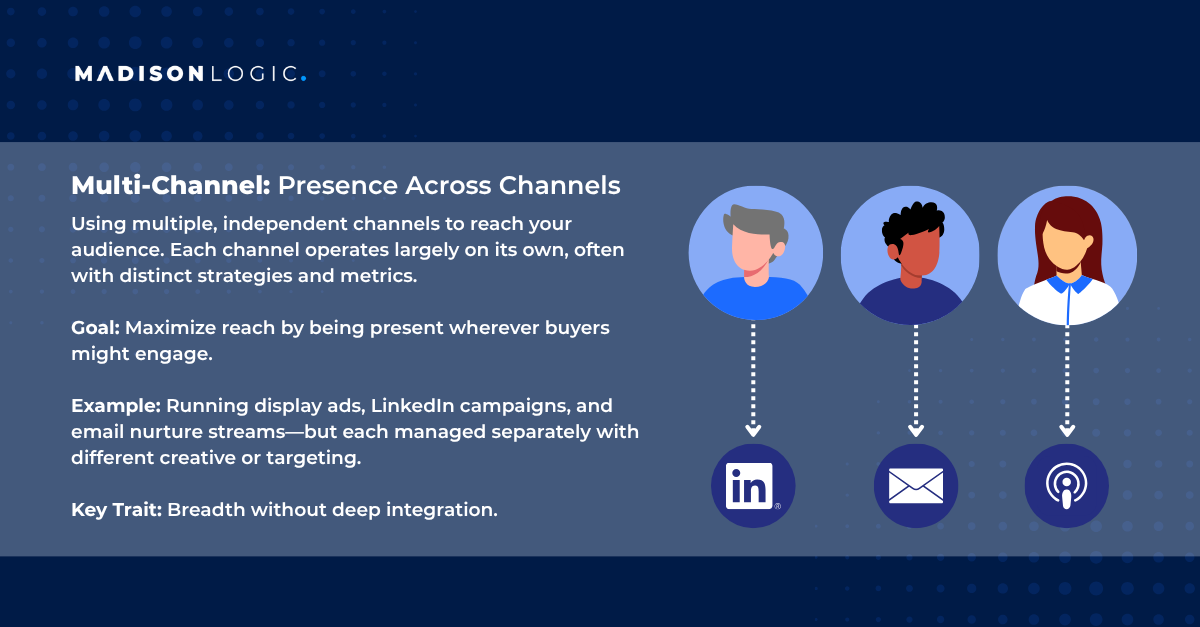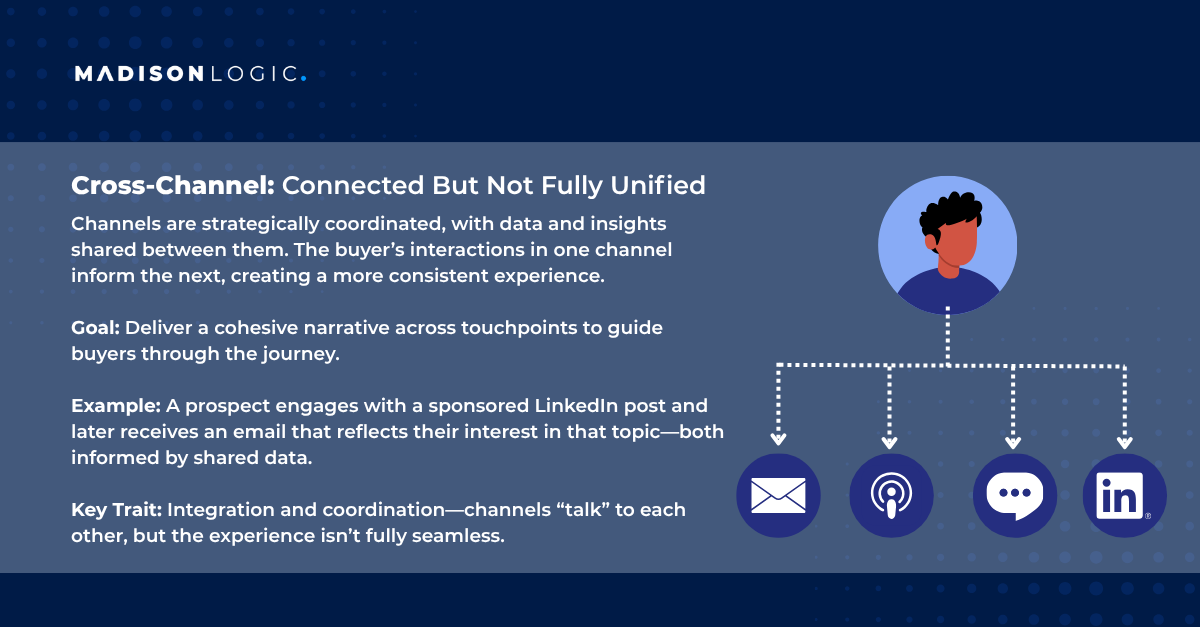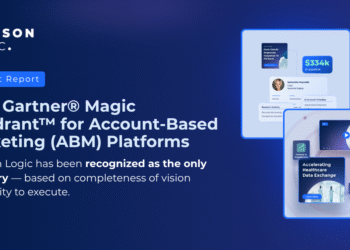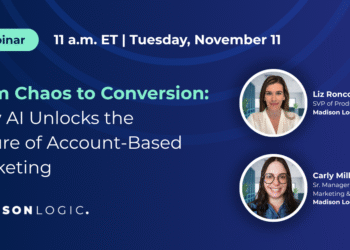With 73% of consumers now using multiple channels during their shopping journey, it’s clear your B2B buyers are doing the same. Yet the terms used to describe this reality—multi-channel, cross-channel, and omni-channel—are often used interchangeably, leading to strategic confusion. For B2B marketers, the debate isn’t about choosing one approach; it’s about understanding how to use them together within a unified account-based marketing (ABM) framework.
This guide will demystify each term with clear B2B examples. We will show you how to pivot from a “versus” mindset to an orchestrated strategy that surrounds the entire buying group, creates a seamless buyer’s journey, and drives measurable pipeline impact.
Decoding the Core Concepts: Multi-Channel, Cross-Channel, and Omni-Channel
Understanding the differences between multi-channel, cross-channel, and omni-channel marketing is essential for building an effective ABM strategy. Each approach offers distinct advantages, and knowing when and how to use them will help you engage buying committees more effectively. Let’s break down each concept with B2B-specific examples that show exactly how they work in practice.
Multi-Channel Marketing: Casting a Wide Net
Multi-channel marketing uses multiple, independent channels to engage with your target accounts. Think of it as running parallel campaigns that don’t communicate with each other. Each channel operates in its own silo, with separate strategies, metrics, and data.

In B2B marketing, this might look like running a LinkedIn ad campaign targeting IT decision-makers while simultaneously executing an email nurture sequence to the same account list. The LinkedIn campaign doesn’t know what’s happening in email, and vice versa. Your content syndication program operates independently from your display advertising, even though both target the same accounts.
The strength of multi-channel marketing lies in its reach. You’re meeting buyers where they are, whether that’s social media, email, search, or industry publications. However, the lack of coordination means you might miss opportunities to create more impactful, connected experiences. You could be showing conflicting messages or, worse, overwhelming the same contacts with redundant touchpoints.
Cross-Channel Marketing: Connecting the Dots
Cross-channel marketing takes multi-channel to the next level by integrating your channels so they work together. An interaction on one channel influences or triggers an action on another, creating a more coordinated buyer experience.

Picture this B2B scenario: A prospect from one of your target accounts downloads an eBook through your content syndication program. This action automatically triggers their entry into a personalized display advertising campaign featuring a relevant case study. When they click through and visit your website, that behavior informs your sales team’s outreach strategy and updates the messaging in your email nurture track.
The power of cross-channel marketing comes from its ability to respond to buyer behavior in real time. You’re not just broadcasting messages; you’re creating responsive campaigns that adapt based on engagement. This approach requires more sophisticated technology and data integration, but it delivers more relevant experiences that guide buyers through their journey more effectively.
Omni-Channel Marketing: A Unified Account Experience
Omni-channel marketing represents the gold standard: a seamless, holistic experience across all channels, centered on the account. The experience remains consistent and persistent, regardless of which touchpoint a buyer engages with. More importantly, the buyer’s journey continues smoothly as they move between channels.

In a B2B omni-channel scenario, a member of a buying committee might see a connected TV (CTV) ad about your solution while streaming content. Later, they engage with a LinkedIn post from your company that builds on the CTV message. When they visit your website, the content dynamically personalizes based on their account’s known intent signals, industry, and stage in the buying journey. If they call your sales team, the representative already knows their engagement history and can continue the conversation seamlessly.
What makes omni-channel truly powerful is that it treats the entire account as a single entity, not a collection of individual contacts. Every interaction, regardless of channel, contributes to a unified understanding of that account’s needs and interests. This creates a consistent narrative that resonates with the entire buying committee.
The B2B Distinction: Why ABM Changes the Channel Conversation
B2B marketing fundamentally differs from B2C because you’re not targeting individual consumers but entire buying committees. B2B buying teams now average 14-23 stakeholders, each with different priorities, research habits, and channel preferences. This complexity transforms how you should think about channel strategies.
Consider a typical enterprise software purchase. The IT director might research solutions through technical forums and vendor websites. The CFO prefers executive briefings and ROI calculators delivered via email. The end users seek peer reviews on social media and user communities. Meanwhile, the procurement team focuses on compliance documentation and vendor comparisons. Each stakeholder brings their own perspective and uses different channels to gather information.
This reality makes the traditional “multi vs. cross vs. omni” debate irrelevant for B2B marketers. You can’t choose just one approach when your buyers span multiple roles, generations, and preferences. A millennial product manager expects seamless digital experiences across channels, while a Gen X executive might still value in-person meetings and printed collateral. Your channel strategy must accommodate this diversity.
ABM amplifies this challenge by requiring you to coordinate messaging not just across channels, but across multiple stakeholders within the same account. When five people from the same company are researching your solution simultaneously, disconnected channel strategies create confusion. One stakeholder might receive messaging about cost savings while another sees content about innovation, creating misalignment within the buying committee.
The solution isn’t to pick one channel approach over another. Instead, successful ABM requires you to think about channels as an integrated ecosystem designed to surround and support the entire buying committee throughout their journey.
Building Your ABM Framework: It’s Not “Vs.”, It’s “And”
Effective ABM inherently requires multiple channels working in concert. The most successful B2B marketers don’t debate whether to use multi-channel, cross-channel, or omni-channel approaches. They recognize that multi-channel ABM execution forms the foundation, while cross-channel tactics provide the orchestration, and omni-channel experiences represent the ideal outcome.
Think of it as a maturity model rather than a choice. You start with multi-channel to establish presence across the channels your buyers use. You evolve to cross-channel to create more intelligent, responsive campaigns. You aspire to omni-channel to deliver truly unified account experiences. Each level builds on the previous one, creating increasingly sophisticated engagement strategies.
The data supports this integrated approach. Campaigns using three or more channels see 250% higher purchase rates compared to single-channel campaigns. This isn’t just about being everywhere; it’s about creating multiple touchpoints that reinforce your message and guide accounts through their buying journey.
Your ABM framework should leverage multi-channel reach to ensure you’re present wherever buying committee members research. Use cross-channel intelligence to trigger the right message at the right time based on account behavior. Strive for omni-channel consistency to create a cohesive narrative that resonates with all stakeholders.
This integrated approach also aligns with how modern buyers actually behave. They don’t think in terms of channels; they simply seek information wherever it’s most convenient. By adopting an “and” mentality, you meet buyers on their terms rather than forcing them into your preferred channels.
Activating Your Multi-Channel ABM Strategy
Turning channel strategy theory into ABM reality requires a systematic approach focused on three core pillars. Each pillar builds on the others to create an orchestrated experience that engages entire buying committees effectively. Let’s break down exactly how to implement this integrated approach.
Step 1: Unify Your Data
Your channel strategy is only as good as the data that powers it. Start by combining first-party data from your customer relationship manager (CRM) and marketing automation platform (MAP) with intent data to identify and prioritize in-market accounts. This unified data foundation enables you to understand which accounts are actively researching, what topics interest them, and which stakeholders are engaged.
Look beyond basic firmographics to include behavioral signals across channels. Track content consumption patterns, website visits, search behavior, and social engagement. Layer in technographic data to understand their current tech stack and potential integration needs. This comprehensive view helps you identify not just who to target, but when and how to engage them.
The key is creating a single source of truth that all channels can access. When your display advertising platform knows what content an account downloaded, and your email system knows which ads they clicked, you can create more relevant, connected experiences. This data unification is what transforms isolated channel tactics into orchestrated ABM campaigns.
Step 2: Select the Right Channel Mix
Choosing channels isn’t about personal preference or industry trends. It’s about understanding where your buying committee members actually spend their time and consume information. The right channel mix varies by industry, company size, and even individual roles within the buying committee.
Start with the channels where you have the strongest presence and data. For most B2B companies, this includes email, your website, and the largest B2B social media platform, LinkedIn. Then expand based on where your intent data shows buyers are active. If you’re seeing high engagement with third-party content, add content syndication. If your accounts are consuming video content, consider CTV advertising.
Remember that different channels serve different purposes in the buyer’s journey. Content syndication and SEO help with early-stage research. Social media and display advertising build awareness and consideration. Email and direct mail nurture relationships. Sales outreach and chat close deals. While prescriptive, you need to consider where your buyers are and what channels they engage with throughout the buyer’s journey. That’s why you need to embrace an always-on ABM approach, so that your channel mix spans the full funnel to support buyers at every buying stage.
Step 3: Orchestrate the Message
Consistent, personalized messaging across channels is what transforms a multi-channel approach into a unified account experience. This doesn’t mean using identical content everywhere. It means ensuring all channels tell parts of the same story, adapted for each channel’s unique context and constraints.
Develop a messaging framework that defines core value propositions for each account segment, then adapt these messages for each channel’s format. Your LinkedIn ads might highlight a compelling statistic, while your email expands on the business impact. Your website personalizes content based on the visitor’s industry, and your sales team reinforces these themes in direct conversations.
The magic happens when these messages build on each other. A prospect sees a display ad about reducing operational costs, downloads a guide on the same topic, receives emails with implementation tips, and then has a sales conversation that references their specific engagement history. This orchestration creates momentum that moves accounts through the buying journey more quickly.
Real-world success proves this approach works. Schneider Electric influenced revenue for 21% of its target accounts by implementing a multi-channel ABM strategy. They didn’t just reach more accounts; they accelerated them through the sales pipeline significantly faster by surrounding buying committees with consistent, relevant messaging across channels.
Measuring What Matters: From Channel Metrics to Account-Level Impact
Traditional channel metrics like clicks, impressions, and open rates tell you what happened, not whether it mattered. When you’re investing in sophisticated multi-channel ABM strategies, you need measurements that demonstrate real business impact. This shift from channel-level to account-level metrics is essential for proving ROI and optimizing your approach.
Account engagement serves as your north star metric. Rather than tracking how many people clicked an ad, measure how many stakeholders from target accounts engaged across all channels. Look for increasing engagement depth and breadth within accounts. Are more stakeholders getting involved? Are they consuming more content? Are they moving from passive consumption to active evaluation? These patterns indicate growing account interest far better than any single channel metric.
Pipeline velocity reveals whether your orchestrated approach actually accelerates deals. Compare how quickly multi-channel engaged accounts move through your pipeline versus those touched by only one or two channels. Track stage progression, time in stage, and conversion rates between stages. Accounts exposed to coordinated multi-channel campaigns typically show 23% faster sales cycles because the entire buying committee receives consistent information that addresses their specific concerns.
Revenue influence provides the ultimate proof of success. Track which accounts were touched by your multi-channel campaigns and their eventual contract values. Companies using cross-channel approaches report 89% customer retention rates, significantly higher than single-channel strategies. This isn’t just about landing new accounts; it’s about creating deeper relationships that drive expansion and renewal revenue.
To capture these insights, you need unified reporting that connects channel activities to account outcomes. This means moving beyond channel-specific dashboards to integrated views that show the complete account journey. Track key ABM metrics like account penetration, engagement trending, and multi-touch attribution across your entire channel mix.
The goal isn’t to abandon channel metrics entirely but to contextualize them within account performance. High email open rates matter more when they come from target accounts showing buying signals. Display ad impressions gain significance when they’re part of a coordinated surround-sound campaign. By connecting channel tactics to account outcomes, you can optimize both tactical execution and strategic impact.
Orchestrate, Don’t Just Activate
You’ve seen the difference between multi-channel, cross-channel, and omni-channel approaches. You understand why B2B buying committees require more than isolated channel tactics. Now it’s time to transform this knowledge into action that drives real pipeline impact.
The path forward isn’t about choosing between channel strategies—it’s about orchestrating them into a unified ABM framework that surrounds buying committees with consistent, relevant experiences. Your buyers don’t care about your channel definitions. They care about finding solutions to their business challenges, wherever and whenever they research.
Start by auditing your current channel approach. Are your channels operating in silos, or do they share data and insights? Can you track an account’s journey across touchpoints, or do you lose visibility when they switch channels? Most importantly, does every channel interaction contribute to a coherent narrative that resonates with all stakeholders?
The companies seeing the greatest ABM success have already made this shift from activation to orchestration. They use data-driven decisions to identify which accounts to target, which channels to use, and which messages to deliver. They measure success not by channel performance, but by account progression and revenue influence.
Your next step is clear: implement ABM pilot strategies that test orchestrated approaches with a subset of target accounts. Choose 10-20 high-value accounts and surround them with coordinated campaigns across three or more channels. Track their progression compared to single-channel accounts. The results will prove what the data already shows: orchestrated multi-channel ABM accelerates pipeline and drives larger deals.
Ready to move beyond channel silos and create unified account experiences? Request a demo to see how Madison Logic’s platform empowers your multi-channel ABM strategy with a holistic view of your campaign activities.
















